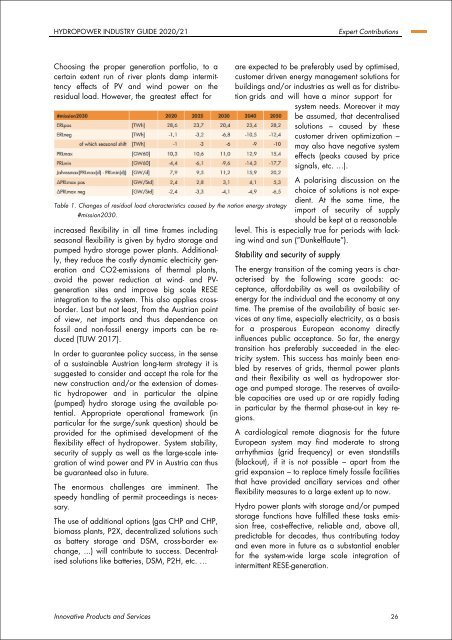VGB PowerTech | Hydro - Hydropower Industry Guide 2020/21
Innovative products and services from operators, suppliers, manufacturers and consultants and a lot of sector information. 1st issue. Final version 2020/21 View online and download on demand!
Innovative products and services from operators, suppliers, manufacturers and consultants and a lot of sector information.
1st issue. Final version 2020/21
View online and download on demand!
Create successful ePaper yourself
Turn your PDF publications into a flip-book with our unique Google optimized e-Paper software.
HYDROPOWER INDUSTRY GUIDE <strong>2020</strong>/<strong>21</strong><br />
Expert Contributions<br />
Choosing the proper generation portfolio, to a<br />
certain extent run of river plants damp intermittency<br />
effects of PV and wind power on the<br />
residual load. However, the greatest effect for<br />
Table 1. Changes of residual load characteristics caused by the nation energy strategy<br />
#mission2030.<br />
increased flexibility in all time frames including<br />
seasonal flexibility is given by hydro storage and<br />
pumped hydro storage power plants. Additionally,<br />
they reduce the costly dynamic electricity generation<br />
and CO2-emissions of thermal plants,<br />
avoid the power reduction at wind- and PVgeneration<br />
sites and improve big scale RESE<br />
integration to the system. This also applies crossborder.<br />
Last but not least, from the Austrian point<br />
of view, net imports and thus dependence on<br />
fossil and non-fossil energy imports can be reduced<br />
(TUW 2017).<br />
In order to guarantee policy success, in the sense<br />
of a sustainable Austrian long-term strategy it is<br />
suggested to consider and accept the role for the<br />
new construction and/or the extension of domestic<br />
hydropower and in particular the alpine<br />
(pumped) hydro storage using the available potential.<br />
Appropriate operational framework (in<br />
particular for the surge/sunk question) should be<br />
provided for the optimised development of the<br />
flexibility effect of hydropower. System stability,<br />
security of supply as well as the large-scale integration<br />
of wind power and PV in Austria can thus<br />
be guaranteed also in future.<br />
The enormous challenges are imminent. The<br />
speedy handling of permit proceedings is necessary.<br />
The use of additional options (gas CHP and CHP,<br />
biomass plants, P2X, decentralized solutions such<br />
as battery storage and DSM, cross-border exchange,<br />
...) will contribute to success. Decentralised<br />
solutions like batteries, DSM, P2H, etc. …<br />
are expected to be preferably used by optimised,<br />
customer driven energy management solutions for<br />
buildings and/or industries as well as for distribution<br />
grids and will have a minor support for<br />
system needs. Moreover it may<br />
be assumed, that decentralised<br />
solutions – caused by these<br />
customer driven optimization –<br />
may also have negative system<br />
effects (peaks caused by price<br />
signals, etc. …).<br />
A polarising discussion on the<br />
choice of solutions is not expedient.<br />
At the same time, the<br />
import of security of supply<br />
should be kept at a reasonable<br />
level. This is especially true for periods with lacking<br />
wind and sun (“Dunkelflaute”).<br />
Stability and security of supply<br />
The energy transition of the coming years is characterised<br />
by the following scare goods: acceptance,<br />
affordability as well as availability of<br />
energy for the individual and the economy at any<br />
time. The premise of the availability of basic services<br />
at any time, especially electricity, as a basis<br />
for a prosperous European economy directly<br />
influences public acceptance. So far, the energy<br />
transition has preferably succeeded in the electricity<br />
system. This success has mainly been enabled<br />
by reserves of grids, thermal power plants<br />
and their flexibility as well as hydropower storage<br />
and pumped storage. The reserves of available<br />
capacities are used up or are rapidly fading<br />
in particular by the thermal phase-out in key regions.<br />
A cardiological remote diagnosis for the future<br />
European system may find moderate to strong<br />
arrhythmias (grid frequency) or even standstills<br />
(blackout), if it is not possible – apart from the<br />
grid expansion – to replace timely fossile facilities<br />
that have provided ancillary services and other<br />
flexibility measures to a large extent up to now.<br />
<strong>Hydro</strong> power plants with storage and/or pumped<br />
storage functions have fulfilled these tasks emission<br />
free, cost-effective, reliable and, above all,<br />
predictable for decades, thus contributing today<br />
and even more in future as a substantial enabler<br />
for the system-wide large scale integration of<br />
intermittent RESE-generation.<br />
Innovative Products and Services 26


















